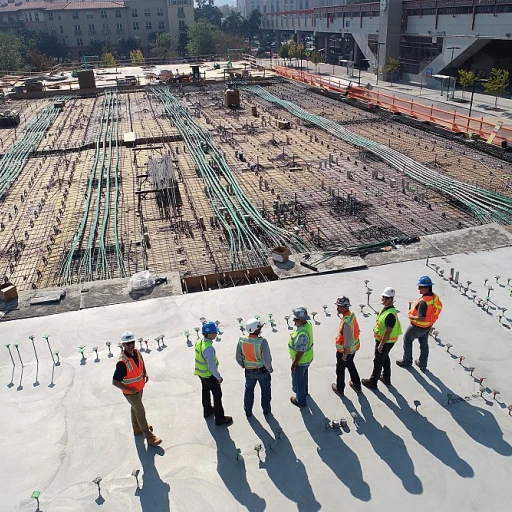Understanding the HR Recruiter's Influence
HR Recruiters: A Critical Component in Retention
The role of a recruiter extends far beyond simply filling an open position. Effective recruitment significantly impacts employee retention by focusing on long-term cultural and skill alignment. Recruiters are not just gatekeepers but strategic partners in acquiring and retaining top talent, making their influence critical in shaping the company culture and work environment.
As the first point of contact for candidates, human resources recruiters set the tone for the entire candidate experience. They must communicate the right blend of company values, mission, and benefits to attract individuals who are not only qualified but also a cultural fit. Engaging potential employees from the outset is crucial, and this process involves understanding the organization’s needs as well as the candidates’ expectations.
A recruiter's influence extends to crafting effective job descriptions and ensuring an engaging onboarding process. These steps, coupled with the integration of continuous engagement and feedback loops, contribute to retention efforts. Recruiters collaborate with hiring managers, aligning the recruitment strategies with overall employee retention goals, ensuring that the right talent is brought on board.
Through platforms like LinkedIn and other social media channels, recruiters can cast a wide net, reaching a diverse pool of qualified candidates. The recruiter’s role is critical in leveraging technology to streamline the hiring process, utilizing applicant tracking systems to efficiently manage resumes and cover letters, ensuring qualified candidates are not overlooked.
In sum, the recruiter’s influence reaches into the core of employee retention, ensuring that the right individuals are not only recruited but also retained, contributing to a healthy and fulfilling workplace dynamic.
Crafting Effective Job Descriptions
Creating Compelling Job Listings
Crafting effective job descriptions is a pivotal task for HR recruiters. The role of a recruiter is not just about filling positions, but about enticing the right talent that fits seamlessly with the company culture and goals. A well-articulated job description serves as the first point of contact between a company and potential candidates. A good job description should clearly outline the role and expectations, while also showcasing the company’s values and culture. It is important to highlight the skills, experience, and qualifications that are essential for the position. This not only attracts qualified candidates but also helps filter out those who may not fit the role. Including specific details about the company’s mission and work environment allows the candidates to assess if they align with the entity's ethos. Moreover, engaging job descriptions can enhance the recruitment process. When structured effectively, candidates gain a precise understanding of what the job entails, which can result in more tailored and thoughtful responses. This can also streamline the hiring process, as hiring managers can better identify resumes that meet the criteria. Incorporating keywords such as “talent acquisition,” “hiring manager,” and “executive search” is also vital. This ensures that your job listing is discoverable in searches conducted by potential candidates on platforms like LinkedIn and various recruitment sites. Consider leveraging social media and other digital platforms to cast a wider net, reaching candidates who might not be actively looking but are open to new opportunities. Exploring the impact of employer branding can further aid in crafting job descriptions that resonate with top talent. By establishing a strong employer brand, companies can attract applicants who are already aligned with their values, helping to ensure a cultural fit from the onset. For more insights on how employer branding influences both attraction and retention of top talent, consider exploring the importance of employer reputation in the recruitment process here. Ultimately, effective job descriptions are more than a list of responsibilities; they are a strategic tool that can set the tone for future engagement, shaping the overall success of talent acquisition endeavors.The Importance of Cultural Fit
Assessing the Fit Within Company Culture
At the heart of every successful hiring process lies the need to ensure that candidates are not only equipped with the necessary skills but are also a good cultural fit for the organization. This is a critical aspect that recruiters have to meticulously evaluate during the recruitment stages.
When companies prioritize cultural alignment, they foster an environment where employees feel a sense of belonging. This is more likely to lead to enhanced retention rates, as employees who resonate with the company's values and mission are generally more engaged.
It all begins with the recruiter job of crafting clear and comprehensive job descriptions. By doing so, the expectations and the cultural tone of the company are clearly communicated to prospective candidates. During the interview process, asking thoughtful interview questions can provide insight into a candidate's compatibility with the company's ethos.
The meticulous matching of candidates to a company’s ethos is enhanced by recruiters leveraging technology in various aspects of the recruitment process. AI-driven tools and platforms like LinkedIn can help identify qualified candidates with profiles that correlate with the organizational culture.
Furthermore, incorporating human-centric recruitment strategies can create organic and meaningful connections, ultimately aiding in identifying top talent. This holistic approach plays an indispensable role in the recruiter's ability to fill positions with candidates who are likely to remain with the company for the long term.
By focusing on cultural fit as part of the recruitment process, organizations can set the foundation for successful onboarding and long-term retention. For further reading on how the recruitment process can enhance retention, consider exploring key insights on employee referrals.
Onboarding as a Retention Tool
Seamless Integration Through Comprehensive Onboarding
The onboarding process stands as a pivotal tool in employee retention, serving to integrate new hires smoothly into the company culture while equipping them with necessary resources. The role of the recruiter does not simply end once the job offer has been accepted. Comprehensive onboarding can significantly increase the retention of new employees by ensuring their alignment with the job expectations from day one. To begin with, clear communication between hiring managers and new employees during onboarding can set realistic expectations. This includes a thorough explanation of the job, the organizational structure, and performance goals. Recruiters and human resource teams need to collaborate to craft onboarding programs tailored to specific roles. Moreover, focusing on the human aspect is essential. Establishing mentoring relationships where new employees can seek guidance fosters an environment of support. Seasoned employees sharing their insights can ease the transition for newcomers, assisting in filling potential knowledge gaps. Leveraging technology plays a crucial role as well. Platforms that allow candidates – now employees – to complete essential onboarding tasks, access resources, and track progress ease the administrative burdens, freeing them up to focus on integration. Applicant tracking systems provide recruiters and HR teams with the tools to track feedback and update onboarding processes effectively. In conclusion, a recruiter’s job is more than just filling positions. The success of a company's talent acquisition and retention depends significantly on how well the onboarding phase is executed. It anchors new employees, intertwining their personal skills and experience with the company's goals, ensuring they remain committed long-term.Continuous Engagement and Feedback
Maintaining a Continuous Dialogue
In the realm of talent acquisition, continuous engagement and feedback play an essential role in fostering employee retention. This ongoing interaction begins well before the formal interview process and extends throughout the employee’s tenure, significantly enhancing their job satisfaction and loyalty to the company.
Engagement begins with recruiters and hiring managers clearly conveying expectations through well-structured job descriptions. This clarity not only attracts qualified candidates but also sets the foundation for a transparent recruiting process. Throughout the recruitment and hiring stages, it is crucial to maintain open lines of communication. Regular updates on the application status, constructive feedback on interview performance, and insightful resume examples can significantly improve a candidate's experience.
Once hiring decisions are made, feedback shifts to focus on the new employee’s integration into the company culture. It is during this period that the human aspect of resources management shines. Organized onboarding sessions, which are initially targeted at skills transfer and familiarization with the role, should gradually evolve into opportunities for personalized feedback, allowing new hires to voice their concerns and gain confidence in their roles.
Moreover, leveraging technology, such as applicant tracking systems and platforms like LinkedIn Recruiter, can provide invaluable insights into employee engagement. These tools aid human resources and recruiting teams in tracking individual growth and satisfaction levels, ensuring preemptive actions are taken if any discrepancies arise in the workplace.
Regular check-ins, surveys, and social media interactions further support recruitment specialists in continually refining their approach, ensuring top talent remains engaged over the long term. By fostering a culture of continuous feedback, recruiters can contribute to a stable and satisfied workforce, ultimately driving the success of the company.








